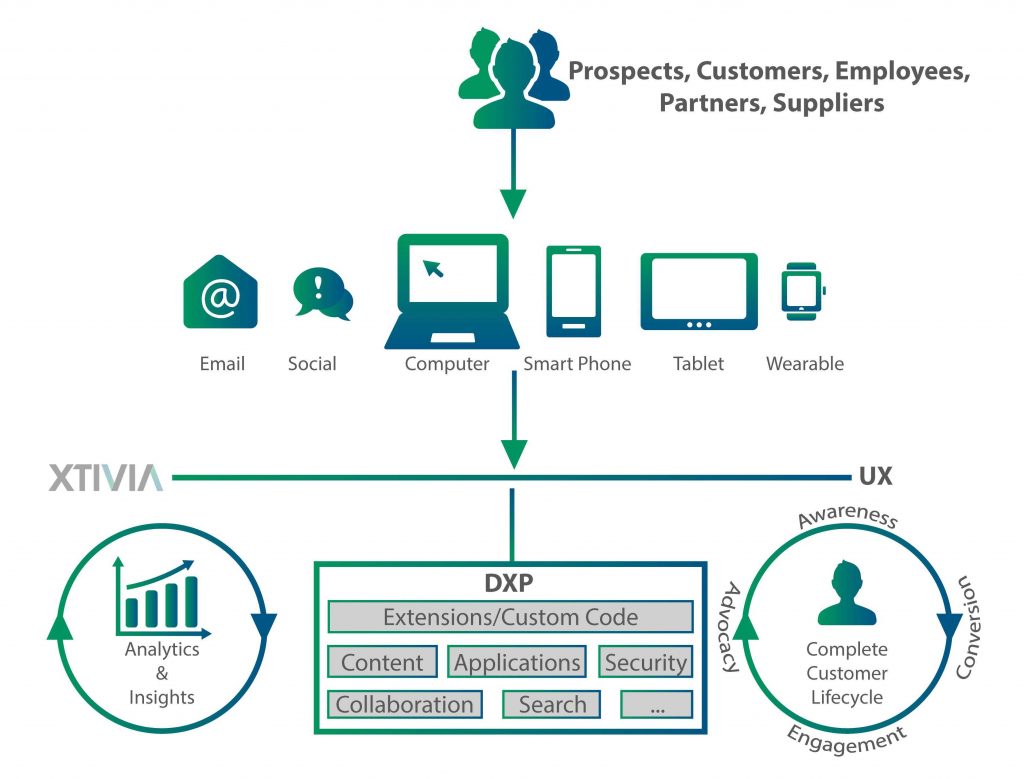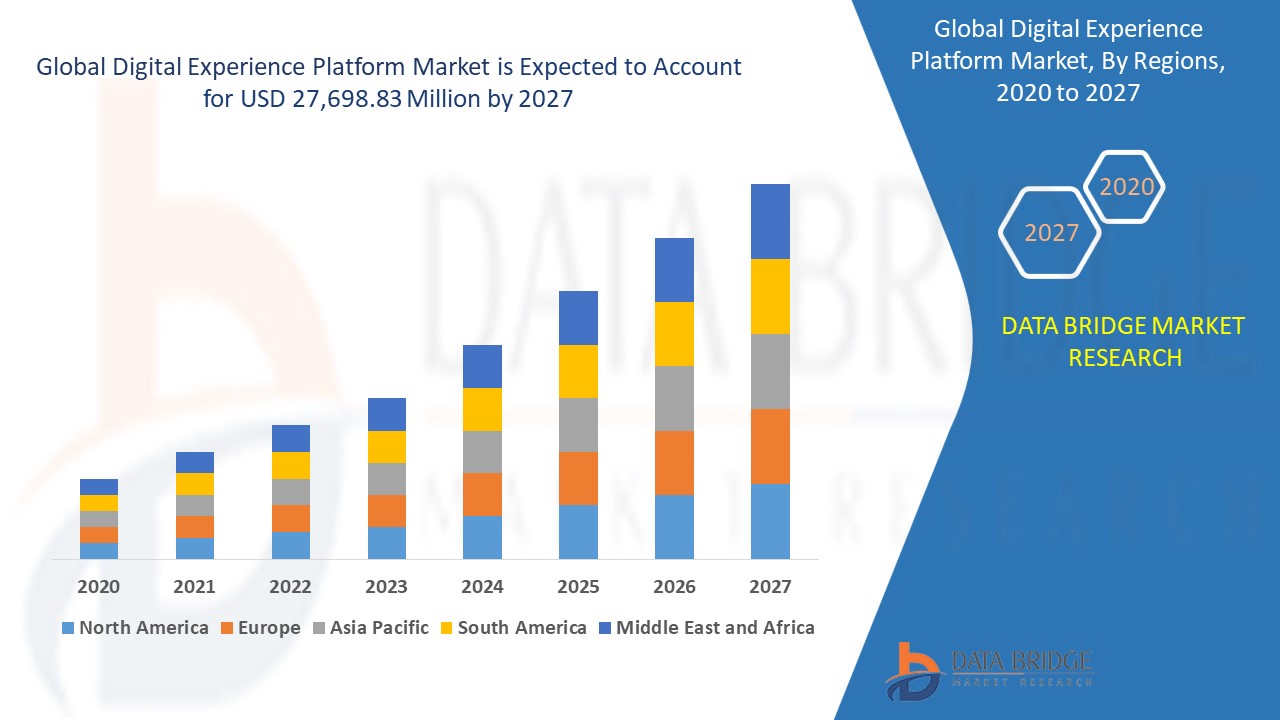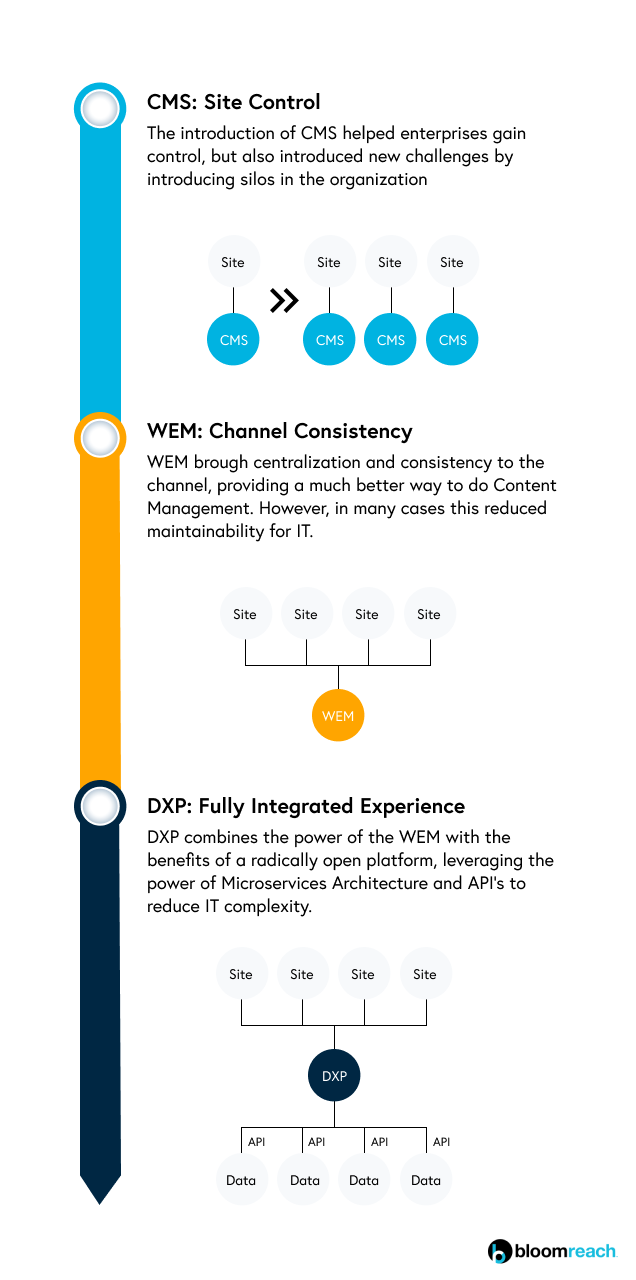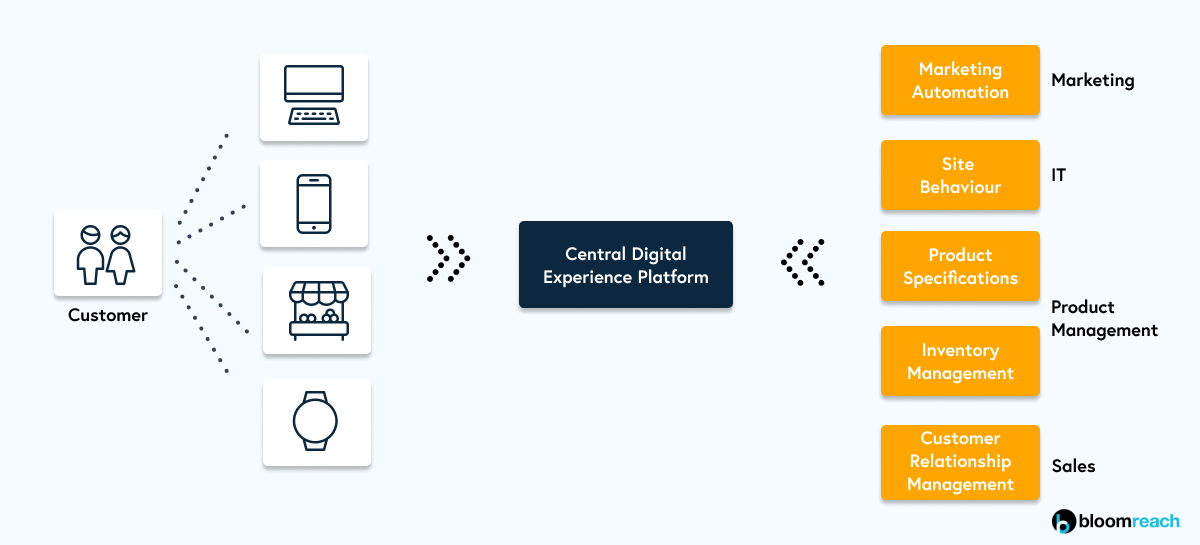Providing an optimum digital platform that is accessible, meaningful as well as communicative of your organisation’s plans and objectives is imperative to creating a healthy brand image and also for being considerate of your customers’ demands and expectations from you. Most consumers today expect a widespread and uniform and digital presence of the brand that they are associating with - a presence that lays everything out on the table and leaves close to nothing behind closed doors.
This is where the concept of a Digital Experience Platform (DXP) comes in. A DXP is an integrated software framework that is used to reach out to a wide horizon of audiences through an array of digital channels and touchpoints. The recent decades of the digital boom have brought it to many organisations’ notice to invest in DXPs to build, deploy and continually improve their websites, applications and digital experiences.
There are two core principles that stand out in the explanation of a digital experience platform.
- Multiple integrated technologies are needed to connect to a wide array of digital touchpoints.
- Management of all of these expanded experiences is done from a central platform that acts as a single control centre.
Let's have a look at the visual definition of a DXP.

A recent report showcased that 47% consumers would abandon a brand that doesn't provide relief and product suggestions and shop from some renowned organisation like Amazon instead. Impact found that companies have been realising the importance of an expanded digital presence, with over 44% of the surveyed companies were presently working towards a digital first approach, while 34% had already undergone a transformation.
Owing to these statistics, it comes as no surprise that the Global Digital Experience Platform Market continues to keep expanding year after year.

Kinds of DXPs
Two of the primary approaches to Digital Experience Platforms are:
Open DXP
A platform that serves as the connective bridge of digital experiences by integrating multiple products from different vendors together so that they can work and perform as one, is an Open DXP. Hence organisations that already have a wide digital presence and own multiple digital experience products will be able to utilize Open DXP better.
Closed DXP
A closed DXP on the other hand is also a one-stop-shop that has all major DXP components - but the differences that all of these components are maintained by a single provider and integrations with other applications is fairly limited.
When it comes to choosing the right approach out of these two, it can be very tricky for an organisation as it depends upon what a certain business might be looking for. For instance, an organisation can avoid closed DXP if it does not want to completely ditch different parts of its platform that are working well for it today. On the other hand, choosing open DXP can be fruitful as it lets a business maintain the part of its experience toolset that is working fine. An Open source DXP can lend flexibility to an organisation’s future. A digital business should still look at what it really wants based on all the different factors.
Based on organisation’s specific use cases, DXP has branched itself into three further categories:
CMS DXPs
For today’s creative agencies that require management tools and creative freedom than what a CMS offers, a CMS (Content Management System) DXP makes the cut by focusing more on the needs of the marketing department as well as the User experience (UX) of the platform. These are particularly sought-after if the business is B2C - where the sale cycle is short and the audience is large, as CMS-heritage DXPs have strong offerings for web-based analytics, user segmentations, advertising and campaigns. Learn more about choosing the right CMS and why Drupal can be the way to go.
Portal DXPs
On the other hand if your business is one of those where long-term customer relationships are valued even after the transaction has been made, a Portal DXP is better suited for the purpose. These trace their origins back to providing customer portals and help businesses understand the factors that lead to better customer loyalty and retention. These DXPs can be especially useful for gathering inputs before providing customer service and assistance in issue resolution.
Commerce DXPs
Commerce DXPs are used for setting up online e-commerce platforms. In addition to product related content delivery and online shopping platform style web interfaces, Commerce DXPs also provide the capabilities related to inventory management, shopping cart, payment integration and checkouts.
DXP vs CMS vs WEM
Now that we're done with defining and analysing the different kinds of DXPs, let’s address the most common query when it comes to these platforms - how is a DXP different from a CMS or a WEM (Web Experience Management)? As the diagram below shows, these similar sounding terms have different use cases and are suited to companies with different goals and aspirations. A DXP has grown out of the limitations posed by a traditional CMS, with regard to creating and managing customer experiences - letting the user dive deeper into the concepts and applications of UX. Forrester's Mark Grannan defines the difference between CMS and DXP as
“Web CMS is critical for developing, managing and optimizing web, mobile, and other content-based experiences. API-first architecture and cloud deployments are reshaping the packaging of digital capabilities into more granular tools that can be assembled on demand.”

A Web Experience Management platform was also born out of newer customer needs, introducing cross-channel functionality for content and data delivery. A WEM enables a brand's business units to share information digitally across channels, and gives the business greater visibility into the user behaviours and personas according to their activities on these channels.
But the ultimate solution for delivering multi-channel marketing and better user experiences emerges in the form of a DXP, as it brings out the best in both worlds.
When do you need a DXP?
But of course, not everyone would require a DXP as it completely depends on an organisation's present needs and future aspirations. One must look out to onboard a DXP if
- Building relationships with your audience throughout the transaction is one of the chief goals of your organisation.
- Your future plans include organising omni-channel experiences that provide you the ability to reach out and deliver content to multiple devices and channels like mobile phones, tablets, email inboxes and social media.
- In a bid to enhance the User Experience of your digital presence, your organisation's pipeline mentions several integrations of new data and platforms to optimise the content and the layouts for your end users.
- Further elaborating on the UX, content personalization and differentiated customer experiences are rated high on importance to retain customers and create value. When you work with a DXP, it does the job of collecting consumer data, defining user personas, and serving custom content to specific audiences, also alongside connecting this data with other channels like social media and mobile applications. Hence, a DXP integrates with other systems and departments to create highly personalized experiences for your audience.
- A platform that does most of the analytical thinking by itself is also great for comprehensive strategizing and planning your roadmaps across channels all while having a single, sturdy management. Not just in the planning, a DXP is also great for retrospection and management of the entire campaign and for incorporating the inputs so received into the workflow.
Choosing the right DXP
While it may seem like a daunting task to choose the perfect digital experience for your enterprise, the job becomes much easier when you go through the process step by step. Choosing the ideal DXP should consist of the following steps.
Map out your requirements
It is easy to get caught up in the flashy new features offered in the market, but you must keep in mind that your company has unique requirements and that the features and functionalities you might have on your wishlist shouldn't just be there because they're an upcoming trend or a buzzword. Anything that you plan to invest on should add value to the organisation. Set realistic goals and about your requirements in a phase by phase manner, ranging from high priority to low priority.
Assess your readiness for transformation
There is quite a lot of change that happens when fundamental decisions like onboarding a DXP are taken. It is now time to analyse whether your content delivery channels and your diverse audience would benefit from this change - and if they would, would they benefit enough for you to go through the ordeal? Is your audience receptive to change and welcomes new initiatives? Or is it more a laid back user base that wants to identify with traditional systems and methodologies? More importantly, do you have enough resources to absorb the changes that come about - i.e., are you ready both in spirit and capacity to make this change?
Onboard some experts
Bigger projects require a broader perspective, so do not take it upon yourself to analyse who the leading technology vendors are and which one to go for, as there is expert help available for that at any point. Keep an eye out for analysts like Gartner and Forrester that constantly release rankings including top players in digital experience, commerce, CMS and the likes. All of these should be considered while the research is undergoing for a new DXP.
Evaluating surrounding ecosystems
Don’t trace the journey without conducting thorough research about what is going on in the market and with your competitors. Note which organisations used which parts of different technologies and tools, and how well these have helped the enterprise to flourish in the duration. Also take the time to examine the goals or features of other businesses that overlap with your organization's and how they have been catalysing their workflow with the use of newer tech. Methods that are already tried and tested will help you out a great deal as there is no better testimony than a practical example.
Also ask your vendor for plenty of references for you to study during the research process to be absolutely sure before finalising a DXP.
Plan a roadmap
Lastly, don’t think only about the present but also the future. There should be a pipeline of tasks that are to be done with regard to the platform in the next few months. Team discussions regarding the execution and usage of the DXP should take place beforehand so that everything works at its optimum.
Benefits of using a DXP
There's a reason why many big organisations seem to be gravitating towards DXPs to take care of their present and future roadmaps. This is because a DXP comes with some pretty solid advantages.
Integrated Controls
DXPs are best suited for multi-channel deliveries and expanding into the far reaches of the web all while keeping a single integrated control panel. A DXP is well equipped to create comprehensive strategies across different platforms all while keeping the operations seamless, and also enabling close collaboration among web page optimisation, content optimisation and also email campaigns. Not only this, you can also rely on the platform for analytics tracking and A/B testings.

Flexibility
DXPs can be pretty dynamic and flexible in application and that is exactly what's needed in the fast evolving world of today. DXPs, owing to their open API (Application Programming Interface) first architecture, are flexible enough to integrate the latest technologies so that you can serve that to your customers as soon as possible. Thus, a DXP is both accommodative of changes in your plans as well as scope of the project, as scalability is one of its primal strengths.
Personalization
As DXPs are great with analysing, tracking, and everything else that constitutes user research before rolling out a product, they also are simultaneously great for creating personalized user experiences of these channels by taking into account the several inputs that they received over these touchpoints. If your business bases itself on creating unique experiences for your customers, a DXP is quite a godsend.
Being future proof
Investing in a platform which is as moldable and customisable as a DXP also is a method of future proofing yourself against an impending technical debt. Apart from this, as organisations dive deeper into the user journeys, relationships that could sustain in the future are also nurtured as needs are understood as well as addressed in a better manner. The information that a DXP gathers for you can turn out to be invaluable in the time to come.
Exploring upcoming digital experience trends
DXP and AI
To study all the data flowing in from multiple sources, analyse it, and to bring forward better content and servicing after reviewing the inputs received and also to continuously maintain and improve the process, artificial intelligence is brought into the loop. The entire concept of a DXP is based on artificial intelligence - AI is interwoven intrinsically in DXP and has access to data from every tool and touchpoint. In turn, the DXP acts as the ultimate seat for the AI to understand and improve the experience from customer acquisition to loyalty.
Voice Interaction
'Smart speakers' constitute a space in the digital sphere that hasn't been mastered yet. But there is no denying that they have become an essential part in the digital experience journey of a customer, and brands that can offer these services seamlessly are sure to have competitive advantage over the others. More about conversational UI here.
Maintaining Privacy
Customer privacy is more important than ever. If you can give your customers the assurance that every data that is collected from them is used for a purpose that they know of, hence involving them into the brand operations, it adds great value to your overall relationship. It shows the end user that you have nothing to hide, that you are transparent, and more importantly, you can be trusted.
The process matters
Consumers will care more about how you do things. Do you tap on the trends to deliver updated content to your user base? Or is your style more laid back and rigid? As business relationships get more intermingled consumers are going to care it's more than just the product that they're purchasing. They are also going to be interested in your method of operations, your digital presence, your accessibility on the various channels you're present in, your problem solving techniques, etc.
Digital will bridge the gap
Digital has been the saving grace during these stressed times, and will continue to be in the saviour even later on. Companies will rely on their digital platforms to access the far reaches of the globe to their scattered audiences. Even within the organisation, a business that is digitally integrated is, in a way, future proof, as it delivers greater visibility into the work of each department and hence better insights on the working of the entire organisation as a whole. This enables one to correct the mistakes faster and achieve greater efficiency faster.
It is inevitable that a business that is flexible, omnipresent, considerate and updated will win the competitive edge in the near future. Hence, it is recommended to start your digital transformation journey as early as possible!


